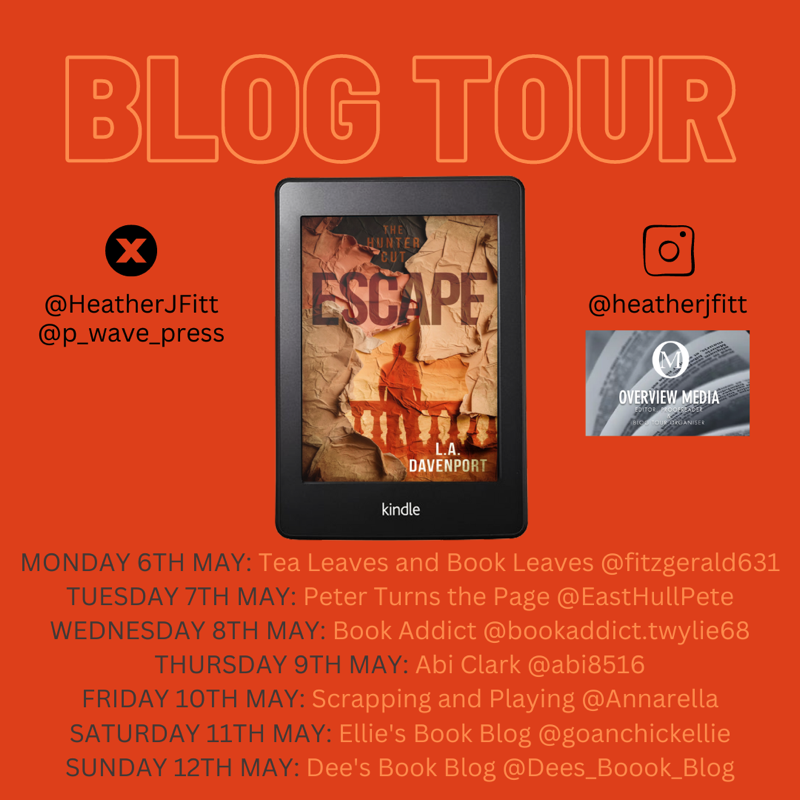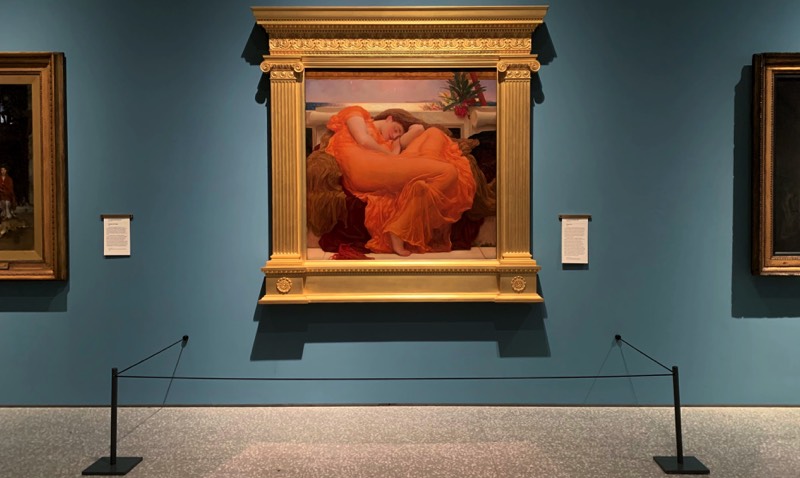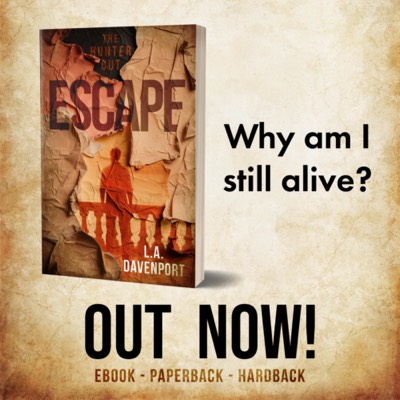Flaming June
Culture, 12 May 2024
by L.A. Davenport
This week I finally got a chance to view in the (gossamer-covered) flesh, so to speak, a painting that has been a subject of fascination for me, and one that has become part of our collective consciousness, if not since it was created but certainly over the past few decades.
The Royal Academy currently has on display in its Collection Gallery, in the Burlington Gardens building, no less than Flaming June, by Frederic, Lord Leighton, which was originally shown at the Academy in 1895 and is now on loan from Museo de Arte de Ponce in Puerto Rico.
In an article for RA Magazine, Rosalind Jana describes the rather tortuous journey that the painting took from Piccadilly to the Caribbean, with it “changing hands several times, loaned to galleries and returned, inherited, sold, lost, and eventually rediscovered behind a wall, or so the story goes, by a builder who was demolishing a house on Clapham Common in 1962.”
From there, Flaming June went to a framer, a barber and then art dealer, before it found its way to Luis A. Ferré, a rather perceptive Latin-American industrialist and former governor of Puerto Rico, who was looking for artworks for his newly created gallery, where it remains to this day.
When I was young, the Victorians and all things associated with them were considered terribly old fashioned. They were seen as stuffy and pretentious, and their style overwrought and cloying.
Just looking at a painting of a 19th century middle class living room made me claustrophobic, with their heavy curtains, thick rugs, lace doilies, oil paintings covering every square inch of wall, and the kind of table lamps one finds only in B&Bs that haven’t been done up since the 1970s.
When I got to university, there were those people, largely English students with a penchant for poetry, who put posters of Pre-Raphaelite paintings on the walls of their rooms, but I was not one of them. (Yes, I liked poetry, and paintings, but I leaned more towards Ezra Pound for the former and Pissarro and Manet for the latter.)
I did of course appreciate the skill on display in the works, but I suppose I would say nowadays that I didn’t connect with them.
Back then, I said they were too sentimental. But over the years I started to see that what I had seen as sentiment was more like yearning. Moreover, I began to appreciate a sophistication and depth to the Pre-Raphaelites in general, and Flaming June in particular, that had previously escaped me.
In her article, Jana tries to establish what it is about Flaming June, of all the paintings exhibited around the time, that has guaranteed its enduring appeal, to the extent that it can almost be seen as a cliché; until you find yourself standing in front of it, that is, and you become aware of its sublime power.
She makes comparisons with other single paintings by artists that have become part of our collective culture, including a favourite of mine, Jean-Honoré Fragonard’s The Swing, and tries to find a link between them. But I feel that do so is akin to trying to pin a Butterfly, or explain a joke: what makes it magical is immediately lost.
In truth, Jana got closest in the opening of her article, where she describes Flaming June as a “summery, sexy work: the epitome of picturesque indolence with its slumbering figure lulled by sea breeze and the scent of oleander, white impasto sunlight dancing on the Mediterranean behind."
“Asleep, the woman is unmoored, drifting mysteriously in her gleaming gilt frame,” she adds.
It is a state we would all like to be in at some point, and in gazing on this “vivid fusion of old and new,” as Jana puts it, we get a little closer to transporting ourselves to another place, and to a sense of peace eternal.
The Royal Academy currently has on display in its Collection Gallery, in the Burlington Gardens building, no less than Flaming June, by Frederic, Lord Leighton, which was originally shown at the Academy in 1895 and is now on loan from Museo de Arte de Ponce in Puerto Rico.
In an article for RA Magazine, Rosalind Jana describes the rather tortuous journey that the painting took from Piccadilly to the Caribbean, with it “changing hands several times, loaned to galleries and returned, inherited, sold, lost, and eventually rediscovered behind a wall, or so the story goes, by a builder who was demolishing a house on Clapham Common in 1962.”
From there, Flaming June went to a framer, a barber and then art dealer, before it found its way to Luis A. Ferré, a rather perceptive Latin-American industrialist and former governor of Puerto Rico, who was looking for artworks for his newly created gallery, where it remains to this day.
When I was young, the Victorians and all things associated with them were considered terribly old fashioned. They were seen as stuffy and pretentious, and their style overwrought and cloying.
Just looking at a painting of a 19th century middle class living room made me claustrophobic, with their heavy curtains, thick rugs, lace doilies, oil paintings covering every square inch of wall, and the kind of table lamps one finds only in B&Bs that haven’t been done up since the 1970s.
When I got to university, there were those people, largely English students with a penchant for poetry, who put posters of Pre-Raphaelite paintings on the walls of their rooms, but I was not one of them. (Yes, I liked poetry, and paintings, but I leaned more towards Ezra Pound for the former and Pissarro and Manet for the latter.)
I did of course appreciate the skill on display in the works, but I suppose I would say nowadays that I didn’t connect with them.
Back then, I said they were too sentimental. But over the years I started to see that what I had seen as sentiment was more like yearning. Moreover, I began to appreciate a sophistication and depth to the Pre-Raphaelites in general, and Flaming June in particular, that had previously escaped me.
In her article, Jana tries to establish what it is about Flaming June, of all the paintings exhibited around the time, that has guaranteed its enduring appeal, to the extent that it can almost be seen as a cliché; until you find yourself standing in front of it, that is, and you become aware of its sublime power.
She makes comparisons with other single paintings by artists that have become part of our collective culture, including a favourite of mine, Jean-Honoré Fragonard’s The Swing, and tries to find a link between them. But I feel that do so is akin to trying to pin a Butterfly, or explain a joke: what makes it magical is immediately lost.
In truth, Jana got closest in the opening of her article, where she describes Flaming June as a “summery, sexy work: the epitome of picturesque indolence with its slumbering figure lulled by sea breeze and the scent of oleander, white impasto sunlight dancing on the Mediterranean behind."
“Asleep, the woman is unmoored, drifting mysteriously in her gleaming gilt frame,” she adds.
It is a state we would all like to be in at some point, and in gazing on this “vivid fusion of old and new,” as Jana puts it, we get a little closer to transporting ourselves to another place, and to a sense of peace eternal.
Also on display at the Royal Academy is an exhibition of Angelica Kauffman, who to my shame I did not know, but was one of the most celebrated and sought-after artists of the 18th century.
I learned that she was known for her portraits of queens, countesses, actors and socialites, and pioneering history paintings, and one can get a sense of how well she was regarded by her inclusion in several contemporary group paintings of important artists.
Personally, I found her works finely wrought and sympathetically balanced in terms of composition and colour, but I suspect that what made her so famous and in-demand at the time is precisely what makes her art seem a little underwhelming when view though a 21st century lens: her paintings lack a little bite and character.
If I was a Famous Person and wanted a Fine Portrait to hang on the wall and display to visitors, I would, without hesitation, head to a present-day Kauffman: a first-drank draughtswoman who will produce a painting that stands on its own as a work of art, but will not delve too far into my character and in doing so expose any shortcomings.
Consequently, I felt a little underwhelmed as I moved from tasteful tableau to tasteful tableau, until I came across four ceiling paintings commission by the Royal Academy to adorn the Council Room at New Somerset House.
As the exhibition catalogue says: “The ‘Elements of Art’ represent the key stages in creating an artwork: ‘Invention, Design, Composition and Colouring’. Diverging from tradition, all four are personified as women.”
It wasn’t so much the subject matter or composition that caught my eye, but rather the broad and textured brushwork, which was clearly intended for viewing from afar but up close gave the paintings an energy and passion that instantly drew me in.
I was captivated, and the technique appeared to come so naturally to Kauffman that I wished she had used it throughout her works.
If she had, she might have been lauded as a pioneer of early impressionism.
I learned that she was known for her portraits of queens, countesses, actors and socialites, and pioneering history paintings, and one can get a sense of how well she was regarded by her inclusion in several contemporary group paintings of important artists.
Personally, I found her works finely wrought and sympathetically balanced in terms of composition and colour, but I suspect that what made her so famous and in-demand at the time is precisely what makes her art seem a little underwhelming when view though a 21st century lens: her paintings lack a little bite and character.
If I was a Famous Person and wanted a Fine Portrait to hang on the wall and display to visitors, I would, without hesitation, head to a present-day Kauffman: a first-drank draughtswoman who will produce a painting that stands on its own as a work of art, but will not delve too far into my character and in doing so expose any shortcomings.
Consequently, I felt a little underwhelmed as I moved from tasteful tableau to tasteful tableau, until I came across four ceiling paintings commission by the Royal Academy to adorn the Council Room at New Somerset House.
As the exhibition catalogue says: “The ‘Elements of Art’ represent the key stages in creating an artwork: ‘Invention, Design, Composition and Colouring’. Diverging from tradition, all four are personified as women.”
It wasn’t so much the subject matter or composition that caught my eye, but rather the broad and textured brushwork, which was clearly intended for viewing from afar but up close gave the paintings an energy and passion that instantly drew me in.
I was captivated, and the technique appeared to come so naturally to Kauffman that I wished she had used it throughout her works.
If she had, she might have been lauded as a pioneer of early impressionism.

“If you like crime mystery this book is for you.”
This week has not only seen the launch of the all-new edition of my first novel, Escape, the Hunter Cut, but also an accompanying blog tour.
It’s been very exciting to read everyone’s reviews and, while I will do a full round-up next week, I’ll give you a taster of what people have said so far:
An “entertaining story that will keep you gripped to the end…I could not put it down...The descriptions in the book were brilliant. It made me feel I was in the Mediterranean with John…If you like crime mystery this book is for you. Emma Fitzgerald
“There is plenty of action for the thriller lover" in Escape, The Hunter Cut, alongside "the brutal violence that comes with the subject matter." Peter Fleming
It "started slow and really got dramatic towards the end…There is a dark side to this escape to the Mediterranean." Abi Clark
Escape, The Hunter Cut, is a “gritty and twisty story” and a “poignant thriller…The moment the action starts it’s an adrenaline fuelled story that keeps you on the edge and turning pages.” Annarella
Find out more and get your copy here.
It’s been very exciting to read everyone’s reviews and, while I will do a full round-up next week, I’ll give you a taster of what people have said so far:
An “entertaining story that will keep you gripped to the end…I could not put it down...The descriptions in the book were brilliant. It made me feel I was in the Mediterranean with John…If you like crime mystery this book is for you. Emma Fitzgerald
“There is plenty of action for the thriller lover" in Escape, The Hunter Cut, alongside "the brutal violence that comes with the subject matter." Peter Fleming
It "started slow and really got dramatic towards the end…There is a dark side to this escape to the Mediterranean." Abi Clark
Escape, The Hunter Cut, is a “gritty and twisty story” and a “poignant thriller…The moment the action starts it’s an adrenaline fuelled story that keeps you on the edge and turning pages.” Annarella
Find out more and get your copy here.
© L.A. Davenport 2017-2024.
0 ratings
Cookies are used to improve your experience on this site and to better understand the audience. Find out more here.
Flaming June | Pushing the Wave

